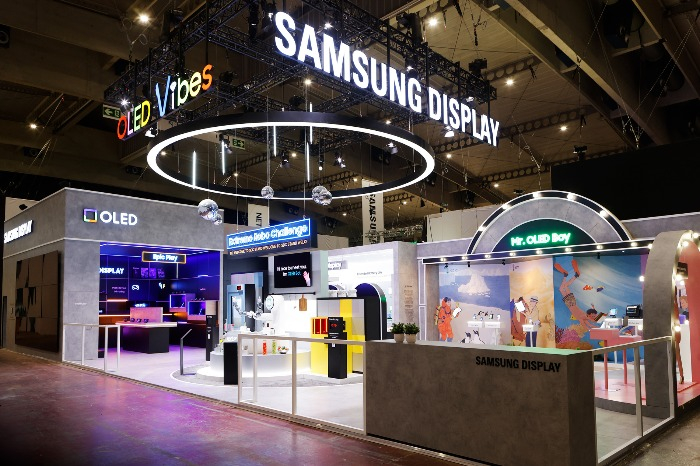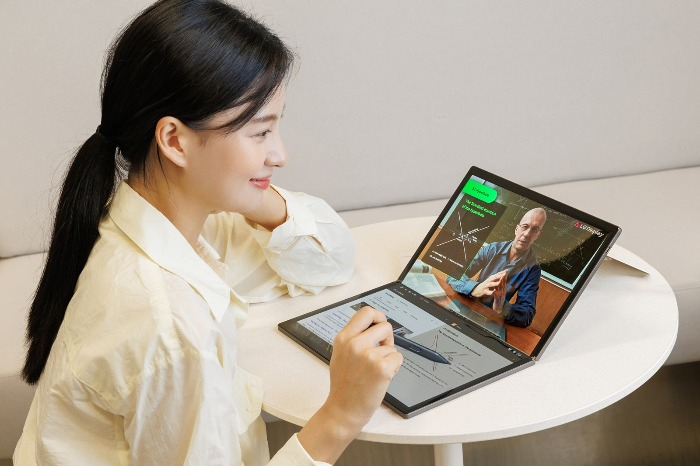New iPad Pro to feature Samsung, LG OLED screens
Samsung and LG will supply a total of 8.5 million panels for the new 11- and 12.9-inch iPad Pro models worth about $2.9 billion
By Mar 05, 2024 (Gmt+09:00)
LG Chem to sell water filter business to Glenwood PE for $692 million


KT&G eyes overseas M&A after rejecting activist fund's offer


Kyobo Life poised to buy Japan’s SBI Group-owned savings bank


StockX in merger talks with Naver’s online reseller Kream


Meritz backs half of ex-manager’s $210 mn hedge fund


South Korea’s two leading display makers Samsung Display Co. and LG Display Co. are said to have been chosen by Apple Inc. to supply all the 8.5 million organic light-emitting diode (OLED) panels for the new iPad Pro models due out later this month after beating Chinese rivals.
According to sources in the display industry on Tuesday, Samsung Display and LG Display are expected to supply 4 million and 4.5 million cells of OLED panels for the new 11- and 12.9-inch iPad Pro models, respectively, this year.
Apple is said to have decided to employ OLED panels for the iPad Pro models set for launch later this month instead of liquid crystal displays (LCDs) for better screen quality.
Based on global display industry tracker Omdia’s respective price projections for 11 and 12.9-inch OLED panels at $290 and $390 per unit, the total value in Samsung and LG orders for the new iPad Pro models is estimated at $2.9 billion.
The two companies are expected to mass-produce their respective OLED panels for the iPad Pro at their Gen 6 fabs.

This is the first time the Korean duo has been commissioned to supply all the OLED panels for the iPad series amid the rapid ascent of Chinese rivals in the OLED display market.
China’s No. 1 display maker BOE Technology Group took over the global OLED market for foldable phones with the largest 42% share in the final quarter of last year.
To ward off Chinese rivals, Samsung and LG have shifted their focus to information technology (IT) OLED panels, mainly used in tablet PCs and laptops, from TV and smartphone OLED panels.
The Korean display majors’ bet paid off by winning all the panel orders for the new iPad Pro models after beating Chinese peers, including BOE.
MORE INVESTMENT IN IT OLED PANELS
Competition to win new iPad OLED panel orders has heated up since last year. Samsung Display and LG Display chief executives flew to Apple’s headquarters in Cupertino, California in an an aim to win the OLED panel orders for the new iPad series.
BOE, which has supplied some OLED panels for iPhone models since 2020, was also reported to have joined the race.

Following the latest victory, Korean display makers are expected to expedite their efforts to widen the gap with Chinese rivals in the mid-size OLED panel market, not only for notebooks but also gaming monitors.
Whereas the TV and smartphone OLED market growth has been stalling, demand for OLED panels for IT devices is poised to take off as an increasing number of laptop and tablet PC companies opt for OLED screens to enhance display quality.
Currently, most IT devices employ LCD screens, suggesting that there is room for OLED demand growth in the market.
According to Omdia, table PC OLED panel shipments are forecast to more than double to 27.3 million cells in 2027 from 12.1 million this year. Laptop OLED panel shipments are projected to increase by a whopping 476.5% to 29.4 million from 5.1 million over the same period.
Laptop and tablet PC panels are also bigger than those for smartphones, guaranteeing higher profitability.

To remain the top players, LG and Samsung are expected to invest actively in IT OLED technology.
In April last year, Samsung Display announced a plan to pour in 4.1 trillion won ($3.1 billion) by 2026 to build a Gen 8.6 IT OLED panel fab with a 2,620x2,290 millimeter substrate.
With a wider substrate, more panels can be produced, meaning less cost. The Gen 8.6 glass substrate can produce 88 pieces of 44-inch OLED cells.
LG Display has been considering an investment in its own Gen 8.6 OLED fab and is expected to commence the fab construction earlier than expected after winning the new iPad Pro panel orders.
On Monday, the company announced a plan to raise 1.29 trillion won through a rights offering and will use some of the proceeds to expand its OLED panel shipments.
XR OLEDoS

The Korean display majors are eyeing OLED panels for extended reality (XR) gears as the next big thing.
The so-called OLEDoS panel, or OLED on silicon, uses silicon instead of a glass substrate to produce high-resolution microdisplays.
Using the OLEDoS technology, it is possible to produce 4K resolution on a stamp-sized display.
Apple’s Vision Pro uses OLEDoS panels provided by Sony Corp.
Samsung Display plans to develop OLEDoS panels for an XR gear to be released by Samsung Electronics Co. this year, while LG Display is in talks to supply OLEDoS panels for the XR device to be developed and introduced by LG Electronics Inc. and Meta Platforms Inc. early next year.
The two panel makers are said to have completed the development of their prototypes.
Samsung Display and LG Display have also been the OLED panel suppliers of Apple's iPhone series.
Write to Jeong-Soo Hwang at hjs@hankyung.com
Sookyung Seo edited this article.
-
 ElectronicsLG Display to raise $971 mn in rights offering for OLED business
ElectronicsLG Display to raise $971 mn in rights offering for OLED businessMar 04, 2024 (Gmt+09:00)
1 Min read -
 Artificial intelligenceMeta’s AI, XR push to gain speed with Korea’s support
Artificial intelligenceMeta’s AI, XR push to gain speed with Korea’s supportFeb 29, 2024 (Gmt+09:00)
3 Min read -
 Korean innovators at CES 2024LG Display to premiere 480Hz gaming OLED at CES 2024
Korean innovators at CES 2024LG Display to premiere 480Hz gaming OLED at CES 2024Jan 04, 2024 (Gmt+09:00)
2 Min read -
 ElectronicsSamsung Display sues BOE over iPhone 12 panel patents
ElectronicsSamsung Display sues BOE over iPhone 12 panel patentsJun 30, 2023 (Gmt+09:00)
2 Min read -
 ElectronicsSamsung Display buys US OLED microdisplay maker for $218 mn
ElectronicsSamsung Display buys US OLED microdisplay maker for $218 mnMay 18, 2023 (Gmt+09:00)
1 Min read -
 EarningsSamsung Display enjoys record profit on Apple iPhone 14
EarningsSamsung Display enjoys record profit on Apple iPhone 14Jan 31, 2023 (Gmt+09:00)
1 Min read -
 Tech, Media & TelecomSamsung Display to build Micro OLED line for VR, AR devices
Tech, Media & TelecomSamsung Display to build Micro OLED line for VR, AR devicesDec 21, 2022 (Gmt+09:00)
3 Min read


